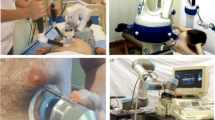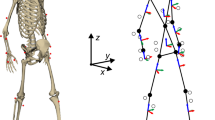Abstract
Purpose
This paper presents a new micro-motion-based approach to track a needle in ultrasound images captured by a handheld transducer.
Methods
We propose a novel learning-based framework to track a handheld needle by detecting microscale variations of motion dynamics over time. The current state of the art on using motion analysis for needle detection uses absolute motion and hence work well only when the transducer is static. We have introduced and evaluated novel spatiotemporal and spectral features, obtained from the phase image, in a self-supervised tracking framework to improve the detection accuracy in the subsequent frames using incremental training. Our proposed tracking method involves volumetric feature selection and differential flow analysis to incorporate the neighboring pixels and mitigate the effects of the subtle tremor motion of a handheld transducer. To evaluate the detection accuracy, the method is tested on porcine tissue in-vivo, during the needle insertion in the biceps femoris muscle.
Results
Experimental results show the mean, standard deviation and root-mean-square errors of \(1.28^{\circ }\), \(1.09^{\circ }\) and \(1.68^{\circ }\) in the insertion angle, and 0.82, 1.21, 1.47 mm, in the needle tip, respectively.
Conclusions
Compared to the appearance-based detection approaches, the proposed method is especially suitable for needles with ultrasonic characteristics that are imperceptible in the static image and to the naked eye.








Similar content being viewed by others
References
Matalon TA, Silver B (1990) US guidance of interventional procedures. Radiology 174(1):43–47
Chin Ki Jinn, Perlas Anahi, Chan Vincent W S, Brull Richard (2008) Needle visualization in ultrasound-guided regional anesthesia: challenges and solutions. Reg Anesthesia and Pain Med 33(6):532–544
Ayvali E, Desai JP (2015) Optical flow-based tracking of needles and needle-tip localization using circular hough transform in ultrasound images. Ann Biomed Eng 43(8):1828–1840
Uhercik M, Kybic J, Liebgott H, Cachard C (2010) Model fitting using ransac for surgical tool localization in 3D ultrasound images. IEEE Trans Biomed Eng 57(8):1907–1916
Zhao Y, Cachard C, Liebgott H (2013) Automatic needle detection and tracking in 3d ultrasound using an ROI-based RANSAC and Kalman method. Ultrasonic imaging 35(4):283–306
Ding M, Fenster A (2004) Projection-based needle segmentation in 3D ultrasound images. Comput aided surg : int Soc Comput Aided Surg 9(5):193–201
Wu Q, Yuchi M, Ding M (2014) Phase grouping-based needle segmentation in 3d trans-rectal ultrasound-guided prostate trans-perineal therapy. Ultrasound in Med Biol 40(4):804–816
Beigi P, Salcudean T, Rohling RN, Lessoway VA, Ng GC (2015) Needle trajectory and tip localization in 3D ultrasound using a moving stylus. Ultrasound in Med Biol 41(7):2057–2070
Zhao Y, Shen Y, Bernard A, Cachard C, Liebgott H (2017) Evaluation and comparison of current biopsy needle localization and tracking methods using 3D ultrasound. Ultrasonics 73:206–220
Adebar TK, Fletcher AE, Okamura AM (2014) 3D ultrasound-guided robotic needle steering in biological tissue. IEEE Trans Biomed Eng 61(12):2899–2910
Hakime A, Deschamps F, De Carvalho EGM, Barah A, Auperin A, De Baere T (2012) Electromagnetic-tracked biopsy under ultrasound guidance: preliminary results. Cardiovasc interv radiol 35(4):898–905
Sviggum HP, Ahn K, Dilger JA, Smith HM (2013) Needle echogenicity in sonographically guided regional anesthesia: blinded comparison of 4 enhanced needles and validation of visual criteria for evaluation. J Ultrasound in Med 32(1):143–148
Kim C, Chang D, Petrisor D, Chirikjian G, Han M, Stoianovici D (2013) Ultrasound probe and needle-guide calibration for robotic ultrasound scanning and needle targeting. IEEE Trans Biomed Eng 60(6):1728–1734
Cowan NJ, Goldberg K, Chirikjian GS, Fichtinger G, Alterovitz R, Reed KB, Kallem V, Park W, Misra S, Okamura AM (2011) Robotic needle steering: Design, modeling, planning, and image guidance. Surgical robotics. Springer, New York, pp 557–582
Boctor EM, Choti MA, Burdette EC, Webster RJ (2008) Three-dimensional ultrasound-guided robotic needle placement: an experimental evaluation. Int J Med Robot Comput Assist Surg 4(2):180–91
Stephanie Cheung, Robert Rohling (2004) Enhancement of needle visibility in ultrasound-guided percutaneous procedures. Ultrasound in Med Biol 30(5):617–624
Beigi P, Salcudean T, Rohling RN, Lessoway VA, Ng GC (2016) Automatic detection of a hand-held needle in ultrasound via phased-based analysis of the tremor motion. In: SPIE medical imaging, pp 97860I-1–97860I-6
Beigi P, Salcudean T, Rohling RN, Ng GC (2016) Spectral analysis of the tremor motion for needle detection in curvilinear ultrasound via spatio-temporal linear sampling. Int J Comput Assist Radiol Surg 11(6):1183–1192
Poggio T, Cauwenberghs G (2001) Incremental and decremental support vector machine learning. Adv neural inform process syst 13:409
Acknowledgements
This work is jointly funded by the Natural Sciences and Engineering Research Council of Canada (NSERC) and the Canadian Institutes of Health Research (CIHR). Thanks to Philips Ultrasound for supplying the ultrasound machine and research interface.
Author information
Authors and Affiliations
Corresponding author
Ethics declarations
Conflict of interest
The authors declare that they have no conflict of interest.
Ethical approval
All applicable international, national, and/or institutional guidelines for the care and use of animals were followed.
Rights and permissions
About this article
Cite this article
Beigi, P., Rohling, R., Salcudean, S.E. et al. CASPER: computer-aided segmentation of imperceptible motion—a learning-based tracking of an invisible needle in ultrasound. Int J CARS 12, 1857–1866 (2017). https://doi.org/10.1007/s11548-017-1631-4
Received:
Accepted:
Published:
Issue Date:
DOI: https://doi.org/10.1007/s11548-017-1631-4




